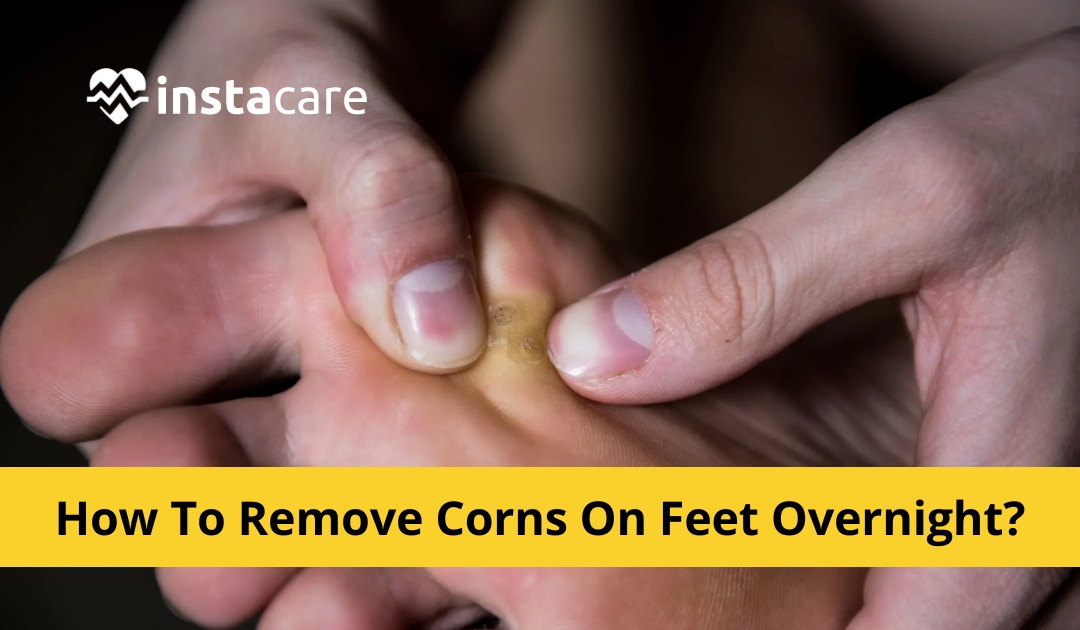Corns, which are challenging, thickened areas of skin on foot, are a common problem. Corns are not a type of skin condition. They are caused by your body's reaction to friction or pressure on your skin. They are similar to calluses but usually more challenging, smaller, and painful. Corns, while not harmful, can irritate.
Moreover, women are more likely to be impacted than men. There are two main types of corn. Hard corn is the most common type of maize. As a result, we'll look at how to remove corn on feet overnight and treat them at home.
Corn Diagnosis
It is not necessary to use specialized tests to diagnose corn. Direct examination of the corn and surrounding skin is all that is required.
- Corns are frequently rounded on the sides and tops of the
foot.
- The main difference between calluses and corns is that a
callus is not painful to the touch.
- Maize may be painful to touch due to irritated skin, and its
center may be swollen.
How To Get Rid Of Corns On Your Feet Overnight
Before treating corn, you must first identify the source of the problem. They frequently disappear on their own when the pressure or friction that is causing them subsides. If preventing further aggravation from the corn does not resolve your problem, dermatologists recommend the following methods to eliminate corn.
1- Soak Your Foot In Warm Water
Ensure the corn is completely submerged for 10 minutes or until the skin softens. Then immerse your foot in warm water laced with moisturizer.
It will have a soothing effect, and you will gradually notice that there are no more dead cells also on the skin of your feet. You can also repeat this strategy several times daily until you no longer feel corn on your skin.
2- Smooth The Corn With A Pumice Stone
Pumice is a porous, abrasive volcanic rock used to exfoliate dry skin. After dipping the maize in warm water, gently file it with the pumice stone. Gently remove the dead skin with circular or lateral motions. Excessive skin removal should be avoided. Excessive filing can cause bleeding and infection.
3- Apply Lotion To The Corn
Use a salicylic acid-containing cream or a moisturizing lotion. Salicylic acid degrades the protein keratin that also makes up the corn and also the surrounding dead skin.
However, salicylic acid is usually not recommended for people with diabetes, poor circulation, or crispy skin. As a result, you must use it with extreme caution. We recommend that you use it under the supervision of a doctor.
View More: How To Remove Black Lines On Teeth
4- Make Use Of Corn-Pads
These donut-shaped adhesive pads will keep the corn from rubbing against your shoes. Cutting or shaving your corns may result in a potentially fatal infection of the surrounding tissues. Corns should only be cut or shaved by a doctor. As a result, refrain from attempting this at home on your own.
5- Make Use Of Vitamin E Oil
Vitamin E benefits your skin and hair and is a well-known natural treatment for foot corn. This is because this vitamin's properties help soften and moisturize skin, while the antioxidants can aid in healing this foot irritation.
6- Sort The Corn
Once your corn has softened, carefully file it down with a pumice stone or emery board (nail file). Lightly file your maize after a 10-minute soak in warm water or a gentle soap and water wipe. Pumice stones are frequently used to treat corn also on the bottom pads of the feet or the tops of the toes. When filing, make sure to use only gentle pressure. Aggressive filing can cause microabrasions in your skin, which is prone to infection fromfungus and bacteria. Furthermore, removing too many layers of skin can result in an open wound that will rub open and worsen with walking or activity.
How Do You Prevent Corns On Your Feet?
To prevent corn from growing or returning after therapy, you
must eliminate the factors that caused them.
Here are some tips to reduce friction and prevent corn from
growing:
- Ask the salesperson to measure also your foot before
selecting shoes that are neither loose nor tight.
- When your feet may be slightly swollen, buying shoes at the
end of the day is a good idea for getting the correct size shoe.
- Reduce the length of your toes. If your toes are too long,
they may be forced to press against your shoe. Maize may eventually form as a
result of the pressure created. Make use of corn pads.
- Wash your feet daily with soap, water, also and the
appropriate scrub brush to keep them clean.
- Keep your feet's skin moist. Apply foot cream regularly to
avoid dryness and friction.
Conclusion
Corns are frequently confused with other foot ailments, such as blisters and warts, so it is critical to be adequately diagnosed if home treatments fail. If you have painful corn, diabetes, sensitive skin, or peripheral artery disease, consult your doctor before attempting a home remedy.

